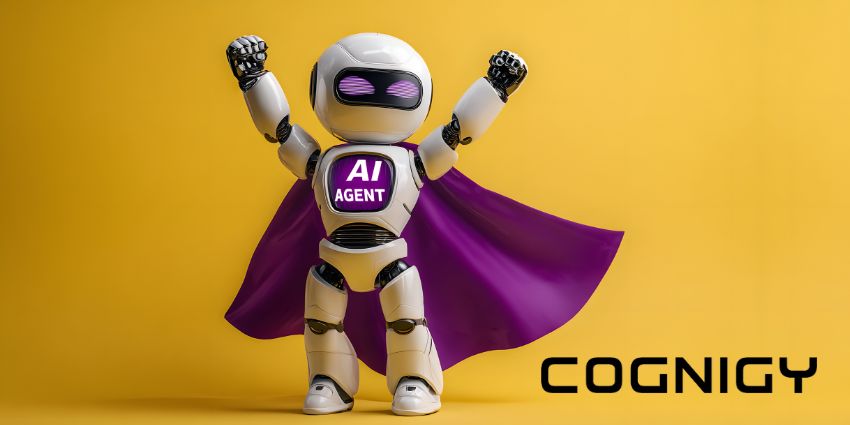“It’s going to be a wild year in conversational AI,” predicted Bradley Metrock – a prominent market thought leader – during a recent CX Today interview.
Given the increased interest in the space after ChatGPT’s almighty rise, this is perhaps no surprise.
Yet, Metrock also suggested that many vendors may face a new “existential risk” as the conversational AI market becomes increasingly crowded.
Indeed, only those that pair an exciting vision with a proven ability to execute will solidify their status in the market and reap the rewards.
Four prominent providers likely to fit that description are Boost.ai, Cognigy, Verint, and Yellow.ai.
Spokespeople from each of these businesses joined this month’s roundtable to discuss the future of conversational AI and how they are building it. They include:
- Raghu Ravinutala, CEO & Co-founder at Yellow.ai
- Sebastian Glock, Director of Product Marketing & Technology Evangelist at Cognigy
- Sanjeev Kumar, VP EMEA at Boost.ai
- Frank Schneider, AI Evangelist at Verint
Read on to learn their thoughts on where the field is heading.
How Is Generative AI Changing the Conversational AI Market?
Ravinutala: From enabling enterprises with goal-based conversations and human-like empathy to ensuring zero-setup and dynamic workflows, generative AI has redefined conversational AI.
After all, generative AI models benefit from extensive pre-training on vast datasets, which enables them to recognize and understand a wide range of user intents.
As such, enterprises can deploy AI-powered virtual agents more quickly and efficiently, ensuring they can handle diverse user inquiries without extensive customization.
For instance, Yellow.ai’s Dynamic Chat eliminates the need to manually create responses, improving customer journey completion rates by as much as 50 percent.
Generative AI-powered, conversational AI solutions can also help marketers to auto-generate AI-suggested contextual templates and tones based on campaign goals and user segments.
Moreover, by leveraging generative AI, virtual agents may now have more human-like conversations, modulate tone, and personalize responses for each individual customer, across various languages.
The result is a tailored service experience at machine speed powered by the Customer Data Platform, vastly improving upon the traditional one-size-fits-all approach.
Glock: As organizations acknowledge the potential of conversational automation, technologies like ChatGPT drive C-level executives to prioritize AI-driven solutions.
Such interest is accelerating innovation and expansion within the market, emphasizing its significance in the digital landscape.
Also, generative AI enables superior customer experiences through human-like, personalized, and customized interactions.
Indeed, sophisticated models like ChatGPT comprehend context, sentiment, and user preferences, fostering customer satisfaction and brand loyalty.
As a result, generative AI advancements will accelerate conversational AI adoption rates in contact centers.
Moreover, businesses will increasingly recognize the value of conversational AI in transforming customer service and communication experiences.
Kumar: Generative AI will improve conversational AI platforms in two fundamental ways:
- Increasing efficiency in building virtual agents by helping scale content and generating training data.
- Helping to augment human support staff by assisting with activities like automatic translation, response suggestions, and summarization.
Additionally, large language models (LLMs) – which underpin generative AI platforms – will further personalize virtual agents for individual users through data analysis.
Nevertheless, generative AI also brings security requirements to the fore, increasing scrutiny on how businesses use, gather, and store data.
Schneider: Generative AI is transforming each element of conversational AI. Front door natural language understanding (NLU) mapping, response authoring, conversation flow orchestration, back-end reporting, custom dashboard creation – generative AI is everywhere.
As such, the technology is helping to create a new game for the conversational AI market.
Moreover, the winner of the new Conversational AI game will have hallmarks of speed to deploy, interoperability, and orchestration across the breadth of CX investments.
Yet, they will do so in a way that enables Conversational AI platforms to be the security gates before and after engagements to maximize this new fuel provided by Generative AI and LLMs.
Which Other Trends Will Continue to Shake Up the Conversational AI Space?
Ravinutala: Humanization of voice AI is a fascinating trend. Soon, branded voicebots that adjust their tone, accent, and speed of response will become the industry standard. They will also comprehend colloquialisms and idioms.
Conversational AI will also continue to enhance speech and visual interfaces, providing more immersive user experiences and allowing for more intuitive interactions.
Finally, the development of domain-specific LLMs will accelerate, not just for text or response generation but as an intelligent orchestration layer.
There, they will enhance end-user experiences and unlock unprecedented value.
Glock: Two key trends will continue to cause disruption. The first is the development of fully integrated, seamless, cross-channel customer journeys.
Indeed, multi-modality is driving the need for a holistic approach to conversational AI, as each channel offers unique benefits and limitations.
Such an approach involves creating interconnected experiences across voice, text, and visual channels, ensuring users can switch between them without losing context or functionality.
Embracing multi-modal platforms will enable organizations to optimize customer engagement, improving satisfaction and increasing loyalty.
The second trend is data-driven decision-making and optimization.
As Conversational AI technologies evolve, contact center managers and AI owners will increasingly leverage sophisticated voice and chat analytics.
With a wealth of new data, businesses gain deeper insights into customer behaviors, preferences, and pain points.
By harnessing this information, businesses can make data-driven decisions to enhance their conversational AI capabilities, optimize user experiences, and drive better overall performance.
Kumar: The significant growth area for conversational AI will be voice and voice assistants.
Smart speakers and voice assistants are already fixtures in many homes, so it’s only a matter of time until virtual agents seamlessly integrate with these home voice assistants.
Pairing these with traditional telephony support, businesses can create a fluid customer ecosystem.
Customers are also increasingly expectant of an omnichannel customer experience. As such, businesses will seek to create a seamless transition between messaging apps, websites, social media, and phone lines so customers can pick up queries across multiple channels.
The trend will drive the need for increased scalability and flexibility in conversational AI platforms, alongside knowledge of the various channels through which customers communicate.
Schneider: Another shift in the conversational AI market is the shift from Product Led Growth (PLG) to what McKinsey calls CX Led Growth.
Enterprises must build customer-centric tools with clear intention and purpose to transform their business processes and technology stack.
To do so, they must discover customer needs, design solutions to meet them, and deliver business impacts with cross-functional reporting that empowers continual change and improvement.
Advances in the conversational AI space have this technology, along with generative AI, uniquely positioned to be the battle axe needed to win with CX Led Growth.
Over the Next 12 Months, What Can We Expect from Your Business In Terms of Conversational AI Innovation?
Ravinutala: We are developing in-house, use-case-specific LLMs and leveraging them as a robust intelligence layer – as evident in the graphic below. This will enable complex conversational AI applications across customer support, marketing, and employee experiences.

In addition, we are working to enhance our goal-oriented conversations feature, making it easier to define and execute a more extensive range of objectives.

We will also invest further in widening the scope of our Dynamic AI agents using dynamic workflow generation and delivering individualized service through a combination of a Customer Data Platform (CDP) and LLMs.
While we are focused on improving the above features, we are also committed to making bot-building more accessible and straightforward.
With our recently launched YellowG solution, users can describe the kind of Dynamic AI agent they need – in natural language – and our platform will automatically build it.
In the coming months, we will further enhance this feature’s capabilities, making it incredibly easy to unlock all the benefits of our technology.
Glock: In the next year, Cognigy will concentrate on incorporating Generative AI technologies into enterprise ecosystems.
Our focus on enterprise readiness will address critical aspects such as data security, system scalability, trustworthy AI, and self-reliance from external APIs.
Cognigy will also endeavor to consolidate our position as a frontrunner in the contact center AI space – as evident in the most recent Gartner Magic Quadrant – by introducing numerous voice and chat automation advancements.
Our objectives extend beyond enhancing human-machine interactions to optimize human-to-human communication.

To this end, we will unveil cutting-edge, inventive tools designed to fortify customer service representatives and propel live support to unparalleled standards.
Lastly, our commitment to customer success will be reflected in our efforts to expedite their return on investment.
By broadening our offering of industry-specific, pre-built turnkey solutions tailored to individual verticals and standard processes, we will enable our clients to swiftly deploy our conversational AI.
Kumar: At Boost.ai, we see LLMs and voice as critical areas for innovation and growth.
Yet, while we are as excited as anyone about generative AI, we have a reputation for security and accuracy that we’re not in a hurry to lose!
Generative AI can be prone to hallucinations and errors, but the LLMs that underpin generative AI remain immensely powerful tools.
Implemented in tandem with our existing platform, we seek to utilize LLMs to build more efficient systems that don’t compromise accuracy and security but drive seamless customer experiences.

Meanwhile, we see voice as the next evolutionary step for generative AI and the next phase for conversational AI to fully enter the mainstream.
Humans are naturally drawn to voice conversations – that’s how we have communicated from time immemorial – so it makes sense for our customer service to reflect that.
We want to bring all the power of generative AI and our conversational AI platform to voice technology and build better customer service worldwide.
Schneider: At Verint, we see conversational AI innovation centering around a “one workforce” approach, our north star of customer engagement. This focuses on humans and AI working together.
Across the breadth of customer experience, conversational AI will enable an approach to CX strategy focused on timely, customized, frictionless support.

From enrolling in and enjoying a service to paying and fixing problems, the goal is for consumers to feel valued and supported by a brand, its tools, and its employees.
Such an ethos empowers agents and employees to feel motivated to deliver the highest level of care and support with conversational AI offering coaching support and intuiting next best actions.
Generative AI plays a role in this innovation by optimizing CX solutions from the summarization of customer conversations to conversational business intelligence data investigations.
Miss out on our previous CX Today roundtable? Check it out here: Top Trends In Workforce Optimization (WFO)







